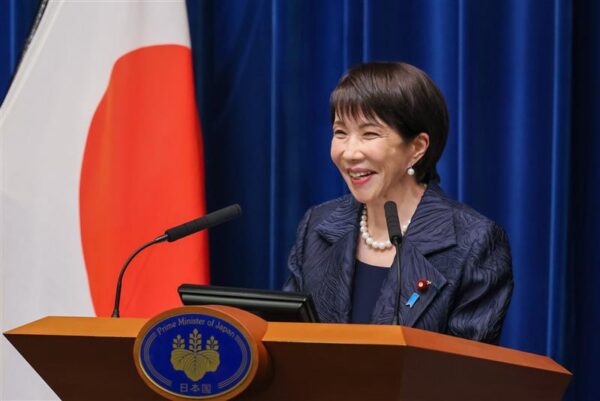Copyright thediplomat

Japan’s new prime minister, Takaichi Sanae, outlined an ambitious vision for Japan’s economy and security in her first policy speech at the Diet on October 24, pledging to confront soaring living costs through aggressive fiscal spending while accelerating a comprehensive military buildup amid growing regional tensions. Takaichi began by declaring her determination to “turn people’s anxieties about the present and future into hope” and to build a strong, resilient economy. More than half of her 20-page address focused on economic policy, as she made the fight against inflation her Cabinet’s top priority. She used the phrase “strong economy” six times in her speech, and even before delivering it, she had reportedly begun preparing an economic stimulus package worth more than 13.9 trillion yen. Stressing that “a strong economy must come first,” Takaichi pledged to implement fiscal spending guided by the philosophy of “responsible and proactive fiscal policy.” Her administration, she said, would seek to raise incomes, improve consumer confidence, and boost business profits in order to increase tax revenues without resorting to higher tax rates. To address the impact of rising prices, Takaichi announced that the government would swiftly compile an economic stimulus package funded by a supplementary budget to be submitted during the current Diet session, which runs through December 17. Among the key measures, she vowed to abolish the provisional gasoline tax rate, which has been in place since 1974, and to raise the income tax exemption threshold from 1.03 million yen to 1.6 million yen this year. She said her administration would design a new system combining income tax deductions and cash benefits for households, while abandoning an unpopular plan for a 20,000-yen cash handout per person – an earlier election pledge that failed to gain traction with the public. Takaichi emphasized that her fiscal expansion would not compromise long-term financial discipline, saying she would focus on reducing the ratio of government debt to gross domestic product rather than targeting a primary balance surplus. “If the increase in outstanding debt is slower than economic growth, financial sustainability will be secured,” she said. She announced the creation of a Growth Strategy Council to map out policies for innovation, industrial revitalization, and “crisis management investments” in areas such as food security. Echoing policies championed by former prime ministers Kishida Fumio and Ishiba Shigeru, she reiterated her commitment to turning Japan into a leading global asset management hub and establishing a national disaster-prevention agency. Takaichi’s speech also sought to consolidate support for her newly formed government, which emerged from months of political turbulence after the Liberal Democratic Party (LDP) lost its majority in both the lower and upper houses. Takaichi won the LDP’s leadership contest on October 4. Less than a week later, the centrist Komeito party ended its 26-year coalition with the LDP, Takaichi’s party then struck a new alliance with the right-leaning Nippon Ishin no Kai, or Japan Innovation Party. The new ruling partnership, however, still lacks a majority in either house, forcing Takaichi to rely on cooperation from opposition parties to pass major bills and budgets. Framing political stability as a prerequisite for effective governance, she said, “Without political stability, we cannot pursue robust economic measures or effective diplomatic and security policies.” She pledged to consider proposals from other parties “flexibly and sincerely,” provided they do not contradict the government’s principles. Some of Nippon Ishin’s hallmark initiatives were reflected in her speech, including the idea of creating a “secondary capital” outside Tokyo to serve as a backup in times of crisis – a concept derived from Nippon Ishin’s Osaka Metropolis Plan. She also called for cross-party discussions on reforming the social security system, seeking to balance benefits and costs amid an aging population and shrinking workforce. Importantly, on national security, Takaichi outlined plans to accelerate Japan’s military buildup and raise defense spending to 2 percent of GDP by fiscal year 2025 – two years ahead of the target set by the Kishida administration in 2022. The initial fiscal year 2025 budget allocated about 9.9 trillion yen on defense, and raising this to 2 percent of GDP would require an additional 1 trillion yen through a supplementary budget. Japan first imposed a ceiling on defense expenditures in 1976, when Prime Minister Takeo Miki capped spending at 1 percent of GNP as a safeguard against remilitarization. Although Prime Minister Yasuhiro Nakasone formally abolished the cap in 1987, the 1 percent limit persisted as a psychological norm. Russia’s invasion of Ukraine in February 2022 reignited debate over Japan’s defense posture, and as NATO members successively committed to spending 2 percent of GDP on defense, then-Prime Minister Kishida pledged in 2022 to meet the same benchmark by fiscal year 2027. Takaichi said the government would revise the three key security documents (the National Security Strategy, the National Defense Strategy, and the Defense Buildup Program) by the end of next year in response to the shifting global environment, including Russia’s invasion of Ukraine and ongoing conflicts in the Middle East. “The free, open and stable international order that we were accustomed to is being violently shaken,” she told lawmakers. “In the region around Japan, military activities and other actions from our neighbors – China, North Korea and Russia – are causing grave concerns.” Her announcement on raising defense spending came just days before U.S. President Donald Trump’s arrival in Tokyo on October 27, after the ASEAN summit in Malaysia. Having U.S. allies increase their defense spending has been a major diplomatic priority for the Trump administration. Calling the Japan-U.S. alliance the “cornerstone” of the nation’s diplomacy and security, Takaichi said she hoped to build a personal relationship of trust with Trump and elevate bilateral ties to “a new level.” Also on the diplomatic front, Takaichi’s policy speech invoked the legacy of her mentor, the late former Prime Minister Abe Shinzo, pledging to restore Japan’s diplomacy “to its rightful place at the heart of the world.” She reaffirmed Japan’s commitment to promoting a “free and open Indo-Pacific,” deepening ties with partners such as South Korea, the Philippines, Australia, and India. While she expressed “deep concern” over the security implications of China’s expanding military activities, she also called Beijing “an important neighbor” and emphasized the need for “constructive and stable” and “mutually beneficial” relations. At the same time, she vowed to use “whatever means possible” to secure the return of Japanese nationals abducted by North Korea. On South Korea, in her inaugural press conference on October 21, Takaichi said “I believe the importance of the Japan-South relationship is greater than ever before,” she said. “Building on the foundation established by previous governments, I would like to develop the relationship in a future-oriented and stable manner.” Interestingly, she added that she likes Korean seaweed, uses Korean cosmetics, and watches K-dramas. Takaichi also briefly addressed immigration. Acknowledging the necessity of foreign labor to compensate for Japan’s demographic decline, she said only those who “follow the rules” would be welcome in the country. “It is a fact that unlawful activity and violation of rules by some foreigners are causing unease and a sense of unfairness among Japanese people,” she said. Earlier during the LDP leadership race, she criticized foreign tourists for “kicking deer” in Japan without citing specific evidence. She has tasked Onoda Kimi, who was appointed both minister for economic security and minister for harmonious coexistence with foreign nationals, to oversee policies covering foreigners, including potential regulations on land purchases by foreigners. Onoda said, “The current reality is that the people are feeling anxiety, dissatisfaction or a sense of unfairness due to crimes, nuisances, and inappropriate use of various systems by a small number of foreign nationals.” The number of foreign residents in Japan reached a record 3.96 million as of late June 2025, accounting for 3.2 percent of the population – up from just 1.0 percent three decades ago. In addition, more than 20,000 babies were born to foreign-national parents in 2024, also marking a record high and representing over 3 percent of all newborns. Among these births, 4,237 were to Chinese mothers, 1,807 to Filipino mothers, and 1,351 to Brazilian mothers, while the largest group – 14,425 births – was categorized as “other nationality,” including countries such as Nepal and Vietnam. Under the LDP and Nippon Ishin’s coalition agreement, the government plans to draft a “population strategy” by fiscal 2026 that will set numerical targets for foreign residents. Despite its breadth, Takaichi’s speech left notable silences. She made no mention of the LDP’s slush fund scandal, which contributed to its election defeats in 2024 and 2025, and the controversy over corporate donations to political parties. Nor did she touch on gender equality and women’s empowerment – an omission that stood out given her status as Japan’s first female premier. She also avoided discussing Nippon Ishin’s proposal to cut 10 percent of lower house seats. Opposition lawmakers have voiced concerns. Noda Yoshihiko, leader of the Constitutional Democratic Party of Japan, warned that the LDP’s new alliance with Nippon Ishin signaled a “rightward shift” in defense and foreign policy. “Instead of Komeito, we will act as a brake on the LDP,” he said. He also expressed concerns over xenophobia. “We have concerns that it may become more exclusionary. While certain regulations are necessary, we respect diversity and ultimately aim to achieve a coexisting society,” he said. Takaichi concluded her address with a call for unity, quoting from the 7th century Seventeen-Article Constitution attributed to Prince Shotoku. “We cannot promote strong economic or security policies without political stability,” she said. Her address encapsulated the twin ambitions of her administration: to revive Japan’s economic vitality through proactive fiscal measures and to secure the nation’s place in an increasingly unstable world through military and diplomatic assertiveness. Although the scale of Takaichi’s spending plans reinforced her reputation as a fiscal hawk and her pledge to accelerate Japan’s defense buildup underscored her conservative credentials, her references to China were notably cautious, and her remarks on domestic immigration issues were careful, reflecting the deliberate restraint she has exercised since taking office, in contrast to some of the more hardline statements she made during the LDP leadership race. She faces the challenge of rebuilding the LDP’s conservative support base while forging cooperation from opposition parties as the leader of a minority government. Also, while the LDP appears to have aligned with Nippon Ishin’s demands in areas such as defense and immigration, it remains to be seen how the party will respond to its new partner’s demands in other areas such as banning corporate political donations and reducing the number of lawmakers.



